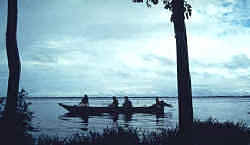Travel
Search
|
|
|
Harlan Hague |
I didn't notice the rain at all. Sitting in the bow of the canoe, I had just landed a pan-size piranha that turned out to be the largest caught on the expedition. On the way back to the riverboat, we saw a large iguana in the branches of a partially- flooded tree. In another, a ten-foot boa.
My companions and I gathered for breakfast on the fantail and talked about the morning's experiences. The other canoe had gone exploring in the submerged forest. They saw a sloth and howler monkeys, and a birder added a half dozen species to his list. My group in the fishing canoe had caught peacock bass and piranha. Our guide said that we could go back to the same spot in the afternoon for swimming. There were no takers. I was content to sit on deck and watch pink dolphins rising alongside the boat.For years, I had wanted to visit the Amazon, but I could never find in the travel literature the sort of experience I was looking for. Until I heard about Moacir Fortes and the Cichla Ocellaris.
Mo is unique. He was born and grew up in a village on the banks of the Amazon. Except for a period when he studied in Germany, he has always lived in Amazonia and knows it intimately. In addition to his native Portuguese, he speaks English, German, Spanish, and is conversant in a few others. His humor is quick, and his enthusiasm, energy, and sheer delight in discovery are contagious.
Mo is a bit of a legend on the middle Amazon. Operators of cruise ships have long sought him out because of his knowledge of the river and the region's flora and fauna. For the past few years, he has been largely on his own, aboard the Cichla Ocellaris, which he had built to his own specifications.
Accommodating a maximum of sixteen guests, the boat draws only three feet of water and
can go where no cruise ship would dare. 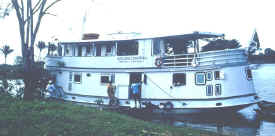 Cabins are
Spartan, no luxury here and none wanted by the adventurer who is drawn to this sort of
experience. The cabins are comfortable, clean and simply furnished, each with bunk beds,
drawers for clothing, and private toilet, basin and shower.
Cabins are
Spartan, no luxury here and none wanted by the adventurer who is drawn to this sort of
experience. The cabins are comfortable, clean and simply furnished, each with bunk beds,
drawers for clothing, and private toilet, basin and shower.
My group boarded the Cichla Ocellaris at Manaus. Now over a million in population, the city was a frontier town during the rubber boom at the turn of the century. The magnificent opera house dates from that prosperous era.
The brown water of the Rio Solimoes and the black water of the Rio Negro join below Manaus and flow side by side for miles before mixing. We cruised first up the Solimoes, the Amazon's main branch, and into the lakes and flooded forests north of the river. Later we cruised the Rio Negro.
We stopped occasionally at floating stores where Mo bought local pineapples, stalks of
bananas, manioc (cassava), a staple food made from an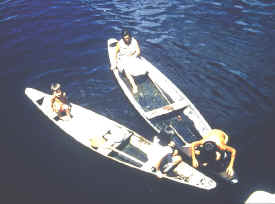 edible, starchy root, and other goods for the boat. At one store, he bought handmade canoe
paddles with characteristic tear-drop blades. I bought two. I would worry later about how
to get them home.
edible, starchy root, and other goods for the boat. At one store, he bought handmade canoe
paddles with characteristic tear-drop blades. I bought two. I would worry later about how
to get them home.
We visited the homes and farms of "caboclos," mixed-blood people who live along the banks, eking out a living from fishing and the thin soil of the cleared forest. They live in stilted or floating houses since the water level can vary as much as forty feet between low and high water.
The river people are so scattered that they must gather occasionally, some traveling for days, for social contact. We stopped at one tiny village, lined with boxlike cabins around the square for housing visitors. The annual gathering at this village is an opportunity to socialize, court, and marry. The priest makes his own annual visit during the gathering.
On a typical day on the river, we gathered on the fantail at first light. After fortifying ourselves with coffee, tea, crackers, bread and jam, we set out in two canoes, actually very stable skiffs. This is the best hour for birds, iguanas, and flowers. We paddled in the flooded forest and occasionally walked on forest trails. On one trek, we saw a group of howler monkeys, waiting patiently in line to jump from one tree to another. Orchids grew in treetops amidst huge philodendrons whose tendrils hung down to take root or to provide vines for transient Tarzans and Janes to swing on. As we paddled through a narrow channel that flowed slowly through a green canyon, beautiful blue morpho butterflies fluttered around us.
We usually returned to the boat around 9:30 for breakfast. All meals were served buffet style under an awning stretched over the fantail. Breakfast included fresh juices, a great variety of familiar and exotic fruits, fish, eggs, and fresh-made bread. Then it was siesta for some, napping or reading in bed, or sitting in the shade on the fantail, talking or reading, and munching on small sweet bananas pulled from hanging stalks.
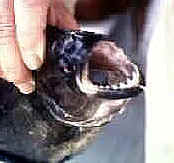 Others set off in a canoe for fishing. Mo is a tireless fisherman.
Once when we were sitting quietly in a canoe, looking for wildlife, he glanced at shaded
shallows and peered intently into the flooded forest. "There's thousands of fish in
there waiting for us," he said, "it makes me so nervous." We caught fish
every day, mostly piranha-- black, golden, red, and white-- but also peacock bass, trout,
and Amazon sardine. That's 'my' piranha in the picture.
Others set off in a canoe for fishing. Mo is a tireless fisherman.
Once when we were sitting quietly in a canoe, looking for wildlife, he glanced at shaded
shallows and peered intently into the flooded forest. "There's thousands of fish in
there waiting for us," he said, "it makes me so nervous." We caught fish
every day, mostly piranha-- black, golden, red, and white-- but also peacock bass, trout,
and Amazon sardine. That's 'my' piranha in the picture.
Buffet lunch always included fish, occasionally chicken, pork, or beef, a crisp vegetable salad, local fresh fruits and vegetables, and for the curious, manioc. I became perfectly addicted to black beans and boiled rice. We were amazed at the fare produced by the cook and her helper from the tiny kitchen, even delicious fresh bread. The small bar on the fantail was surprisingly well stocked, and the prices were reasonable.
Mo usually moved the boat just after lunch, though sometimes we explored in the afternoon as well. On occasion we also cruised during the night.
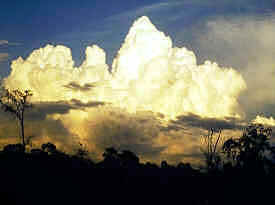 The best exploring was done on the evening excursions, beginning
just after dinner, the menu of which was similar to lunch. Wildlife was abundant at this
hour. We saw iguanas, toucans, blue-and-yellow macaws, green parrots,
yellow- rumped
caciques, horned screamers, umbrellabirds and hoatzins along flooded areas and riverbanks.
Dolphins often surfaced near the canoes. Sunsets were spectacular.
The best exploring was done on the evening excursions, beginning
just after dinner, the menu of which was similar to lunch. Wildlife was abundant at this
hour. We saw iguanas, toucans, blue-and-yellow macaws, green parrots,
yellow- rumped
caciques, horned screamers, umbrellabirds and hoatzins along flooded areas and riverbanks.
Dolphins often surfaced near the canoes. Sunsets were spectacular.
We often stayed out after nightfall. With Mo's strong light, we spotted sloths, night hawks, owls, and snakes, a huge boa, a graceful fer-de-lance, and a beautiful red snake that even he did not know. With the light focused on shining eyes at water level, Mo guided the canoe into the shallows to catch alligators. I was startled when he first handed me a two-foot alligator. "Pass it on," he said.
The nights were indescribably tranquil. Our canoe drifted slowly on one occasion on a mirror-smooth slough, on one side a dark flooded forest, on the other a meadow of floating broad-leafed grasses, beyond a wall of trees, black silhouettes against the dim sky, tree frogs chirping and fireflies twinkling in the forest, stars by the billions, the quiet absolute.
Returning toward the boat, Mo flashed his light rapidly from side to side of the racing canoe. The water on both sides of the boat began to erupt with jumping fish. They sailed toward the light, bounced off us and fell into the canoe. Dodging frantically and laughing hysterically, I expected someone at any moment to fall over the side. Later we counted fifty-three fish, eight to ten inches, in the canoe.
A high point of the trip was a visit to Mo's rain forest hideaway. In a leafy inlet off a tributary of the Rio Negro, he has built an open-sided thatched pavilion with a raised plank floor. Tying up in the shallows, a gangway was put down, and we went ashore for a barbecue. At nightfall, hammocks were slung under the thatch roof. Mo gave us instructions on the proper position for sleeping comfortably in a hammock, not lengthwise inside the hammock, but diagonally with the feet outside. It was terribly rude, he said, to put your feet inside. The hammock was indeed comfortable. The soft rain on the thatch roof and the night sounds completed the setting for a memorable night.
|
Caveat and disclaimer: This is a freelance travel article that I published some time ago. Some data, especially prices, links and contact information, may not be current. |
|
|
|
|
